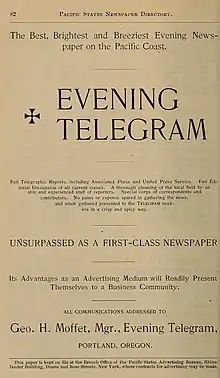Portland News-Telegram
The Portland News-Telegram was one of three daily newspapers serving Portland in the U.S. state of Oregon in the 1930s. It was formed in a 1931 when the Evening Telegram, founded in 1877, was sold to the News, a paper with roots in the East Side News, founded under interesting circumstances in 1906.[1][2][3][4] According to Oregon newspaper historian George Turnbull, following the merger, the character of the consolidated paper reflected the News more than the Telegram, though the Telegram provided "a number of valuable staff members."[3]

The Telegram
The Telegram was founded in 1877 by Henry Pittock, who had founded the Oregonian 16 years prior. His ownership state connected the Telegram to the Oregonian; although the Oregonian was a solidly Republican paper, the Telegram tended to be more Democratic, in order to keep competitors out of the field.[5] A. C. McDonald, one of the owners of the Telegram Publishing Company, was killed in a duel with James K. Mercer, assistant editor of the Portland Bee, in 1878. The paper had a high degree of turnover in its leadership in its first decade. One consistent presence was Catherine Amanda Coburn, sister of Harvey W. Scott and Abigail Scott Duniway, who ran the editorial page from 1883 to 1888, when she left for the Oregonian. Richard D. Cannon, who arrived as editor in 1888, was credited with bringing improved society and sports coverage to the paper. Cannon left the paper in the early 1890s, but returned in 1904. Other editors included J. B. Fithian[6] and S. A. Moreland.[7] Lumbermen John E. and L. R. Wheeler bought the paper in 1914;[5] the Telegram Building, now a historic landmark, was built during their tenure. Several unpopular campaigns, including one against the Ku Klux Klan, brought the paper into bankruptcy.[5] C. H. Brockhagen bought the paper, and was the publisher from 1927 until the 1931 merger with the News.[4]
The News
The East Side News was founded in 1906. It was financed by the Scripps-Canfield publishing house of Seattle, but in complete secrecy, due to a promise E. W. Scripps had made to Sam Jackson of the Oregon Journal, not to compete in the Portland market. In spite of low circulation in its early days, the News constructed a building on Clay St. at a cost of $50,000.[3]
References
- "Oregon Papers Merged: Portland News Buys The Telegram for Scripps-Canfield Group". New York Times. May 6, 1931. p. 21.
- "About The news-telegram. (Portland, Or.) 1931–1939". Chronicling America. Library of Congress. Retrieved April 20, 2019.
- Turnbull, George S. (1939). . . Binfords & Mort.
- Turnbull, George S. (1939). . . Binfords & Mort.
- Writers' Program, Oregon (1940). Oregon, End of the Trail. Portland, Ore.: Binfords & Mort. p. 134.
- Hodgkin, Frank E.; Galvin, J. J. (1882). . Farmer and Dairyman Publishing House. p. 197.
- Hodgkin, Frank E.; Galvin, J. J. (1882). . Farmer and Dairyman Publishing House. p. 184.
External links
- "Research with historical Portland newspapers, beyond the Oregonian" – Multnomah County Library